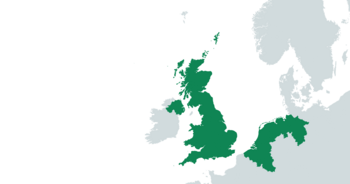Hanoverian Union: Difference between revisions
No edit summary |
No edit summary |
||
| Line 83: | Line 83: | ||
The organisation's agenda is mainly decided and enacted by a legislative body, known as the [[Executive Council of the Hanoverian Union]], which is made up of approximately four members and is overseen by the [[President of the Hanoverian Union]]. By convention, the council would come into session every fifteen years where on each occasion, members would decide on a new agenda, which, upon coming into force, would be officially known as a "Trinational Plan", with the term referring to the tripartite nature of the organisation, which is made up of approximately three member states. However, while the [[President of the Hanoverian Union]] oversees the functions of the [[Executive Council of the Hanoverian Union|Executive Council]], it is otherwise led and chaired by a [[Chairman of the Hanoverian Union|chairman]], who, in turn, is assisted by a [[Deputy Chairman of the Hanoverian Union|deputy chairman]]. Meanwhile, the organisation's agendas are carefully arranged, recorded, and later archived by the organisation's [[Secretary of the Hanoverian Union|secretary]], an office that is usually held by the next-in-line to the chairmanship. | The organisation's agenda is mainly decided and enacted by a legislative body, known as the [[Executive Council of the Hanoverian Union]], which is made up of approximately four members and is overseen by the [[President of the Hanoverian Union]]. By convention, the council would come into session every fifteen years where on each occasion, members would decide on a new agenda, which, upon coming into force, would be officially known as a "Trinational Plan", with the term referring to the tripartite nature of the organisation, which is made up of approximately three member states. However, while the [[President of the Hanoverian Union]] oversees the functions of the [[Executive Council of the Hanoverian Union|Executive Council]], it is otherwise led and chaired by a [[Chairman of the Hanoverian Union|chairman]], who, in turn, is assisted by a [[Deputy Chairman of the Hanoverian Union|deputy chairman]]. Meanwhile, the organisation's agendas are carefully arranged, recorded, and later archived by the organisation's [[Secretary of the Hanoverian Union|secretary]], an office that is usually held by the next-in-line to the chairmanship. | ||
==Formation== | |||
The end of the {{wp|Second World War}} in 1945,while not completely so, had inflicted considerable damage to the economies of the {{wp|United Kingdom}}, the {{wp|Netherlands}}, and {{wp|Luxembourg}}, with towns and cities damaged by bombings from both sides, and the lives of civillians lost to enemy gunfire. | |||
Revision as of 04:33, 31 October 2022
Hanoverian Union | |
|---|---|
| Motto: "Eenheid onder de kroon" (Dutch) "L'unité sous la couronne" (French) "Eenheet ënner der Kroun" (Luxembourgish) "Unity Under The Crown" | |
 | |
| Administrative center | Brussels |
| Other languages | English, Dutch, French, Luxembourgish |
| Leaders | |
| Alexandra | |
• Chairman | David Gauke |
| Wopke Hoekstra | |
| François Bausch Paulette Lenert | |
| Legislature | Executive Council of the Hanoverian Union |
| Establishment | |
| 6 December 1946 | |
| 10 November 1993 | |
| Area | |
• | 365,754.4 km2 (141,218.6 sq mi) |
| Population | |
• 2021 estimate | 105,594,693 |
| GDP (PPP) | 2021 estimate |
• Total | $6.005 trillion |
• Per capita | $56,870 |
| GDP (nominal) | 2021 estimate |
• Total | $5.305 trillion |
• Per capita | $50,246 |
| Gini | 29.2 low |
| HDI (2021) | 0.934 very high |
| Currency | Pound sterling (GBP), Euro (EUR) |
The Hanoverian Union (Dutch: Hannoveraanse Unie French: Union hanovrienne Luxembourgish: Hannoverescher Unioun) is a politico-economic union consisting of three neighbouring countries in Western Europe, namely the United Kingdom, the Netherlands, and Luxembourg, all three of which are constitutional monarchies with a single Hanoverian monarch as their respective head of state, currently Queen/Grand Duchess Alexandra. Formed in 1946 as a result of the Brussels Agreement between the governments of all three countries, the organisation mainly promotes intergovernmental cooperation between its three member states, with the reigning Hanoverian monarch being promoted and seen as a common and unifying identity between the three countries. With an estimated total population of 105 million, the union covers a total area of approximately 365,754.4 km2 (141,218.6 sq mi), while otherwise boasting the third largest economy in the world at $5.305 trillion.
The organisation's agenda is mainly decided and enacted by a legislative body, known as the Executive Council of the Hanoverian Union, which is made up of approximately four members and is overseen by the President of the Hanoverian Union. By convention, the council would come into session every fifteen years where on each occasion, members would decide on a new agenda, which, upon coming into force, would be officially known as a "Trinational Plan", with the term referring to the tripartite nature of the organisation, which is made up of approximately three member states. However, while the President of the Hanoverian Union oversees the functions of the Executive Council, it is otherwise led and chaired by a chairman, who, in turn, is assisted by a deputy chairman. Meanwhile, the organisation's agendas are carefully arranged, recorded, and later archived by the organisation's secretary, an office that is usually held by the next-in-line to the chairmanship.
Formation
The end of the Second World War in 1945,while not completely so, had inflicted considerable damage to the economies of the United Kingdom, the Netherlands, and Luxembourg, with towns and cities damaged by bombings from both sides, and the lives of civillians lost to enemy gunfire.
